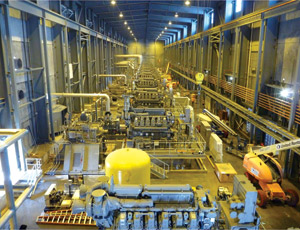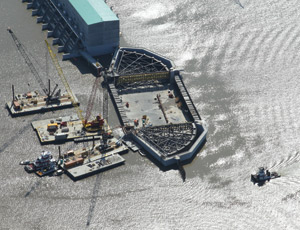As New Orleans' complex $14.6-billion storm-surge risk reduction system—which was federally funded, designed and constructed—races toward substantial completion, local stakeholders now are asking if the federal government will help them maintain it.


The U.S. Army Corps of Engineers' preliminary estimate for the system's annual operations and maintenance is $38.3 million; but that amount represents only the O&M cost of perimeter protections, including surge barriers, pump stations and gates that didn't previously exist.
Tim Doody, president of the Southeast Louisiana Flood Protection Authority-East, which is responsible for area flood defenses on the Mississippi River's east bank, says the figure gives an incomplete picture of local sponsors' responsibility.
Prior to Hurrican Katrina's widespread destruction in 2005, the combined annual O&M costs for the levees, locks, gates and pump stations was $30 million. That total covered the perimeter levees—much of which have been altered, reconstructed or expanded—as well as many internal facilities not included in Corps estimates.
“Those numbers don't include internal floodgates and other internal drainage features, Mississippi River levees, eight major pumping stations, a sector gate and water-diversion structure,” Doody says. “The maintenance of a BMW has got to be more than [an old] Pinto.”
By the end of May, SLFPA-East expects to have an independent and more inclusive O&M cost estimate delivered by AECOM, Los Angeles. “We have to get an accurate assessment before we can go to the voters,” Doody explains.
SLFPA-East requires estimates “that will stand the test of outside review” in order to seek funding from the state or local property owners through taxation or other means, says Robert Turner, SLFPA-East's regional director. “One of the problems we have in the [Corps'] cost estimates for the surge barrier, for example, is that the gates aren't finished yet. We don't even have the manuals.”
Under agreements the Corps and state and local stakeholders negotiated before work began, the Corps is to deliver O&M manuals and as-built drawings upon notification of construction completion, says Mike Park, chief of the Corps' Task Force Hope. The problem is that several structures in the system won't be fully operational until 2012 or later.
In the new, beefed-up system, some of the most complex features have large operating gates across federal waterways. Local stakeholders want the federal government to assume responsibility for those. “We are not complaining about having to do additional O&M on the rest of the system,” Turner says. “It's just those parts of the system that cross navigation channels, that are huge, complicated structures and have an impact on interstate commerce.”
Local stakeholders knew from the start they would bear the burden of O&M but had no idea what they would be operating and maintaining. The acts that funded the work were passed under flood-control and coastal emergency provisions, which means the projects are classified as flood- control works whose maintenance is fully the responsibility of non-federal sponsors. “I don't think anyone at the time imagined the magnitude and complexity that would be required for these structures, nor thought of navigation,” Turner says.
Another hurdle is the future cost of adding levee lifts. Before Katrina, lift costs were shared equally. But the new levees, built under the emergency measures, “would be at full local expense,” Turner says.
The Corps says there will be a need for levee lifts to counter subsidence and sea-level rise after the system is completed, but no congressional authorization or program funding provides for it. Future investment by the federal government will require new authorization and appropriations, according to the Corps.
In March, Doody and Turner met with delegates on the Senate appropriations committee, staffers of the House transportation committee and Steve Stockton, the Corps' director of civil works, in an effort to convince them to give the Corps O&M authority over some of the larger structures crossing navigable waters.
“Shipping interests would prefer to be able to work with the Corps,” says Turner, because it already has broad responsibility for navigation. “Levee districts' main concern is flood protection,” he adds. “Maritime interests—from SLFPA-East's standpoint—would always fall below flood protection interests.”
Reverting O&M authority back to the Corps is not “groundbreaking or precedent-setting,” adds Turner, citing the Corps' assumption of O&M on projects for flood-damage reduction in the city of Woonsocket, R.I., in January 2009.
The Woonsocket project was decertified under the National Flood Insurance Program administered by the Federal Emergency Management Agency in May 2007 because the agency determined the project no longer provided protection from the base flood level. The Corps' New England District assumed O&M in July 2009, upon receipt of funding.
Turner says the situation in New Orleans is extraordinary and should be addressed. “There are significant differences between what would be considered a traditional flood-control project and what is going on here. We will have the largest surge barrier in the world. This is a different animal,” he says.
Turner also notes that, elsewhere in the world, huge barrier structures are owned, operated and maintained by federal authority, while interior flood defenses are relegated to local entities for O&M.
According to Sandra van der Graaf, executive secretary of the Delta Model Advisory Commission, five of the Netherlands' six major surge barriers are operated and maintained by national authorities. Likewise, in England, the Thames and its associated barriers are operated by the national Environment Agency, says Robert Nicholls, a professor in the School of Civil Engineering and the Environment at the University of Southampton.
With no sign yet of a federal Water Resources Development Act this year, prospects for switching any O&M to the Corps don't appear to be good. “There is nobody outside our local delegation that has picked up this banner and run with it,” Turner says. Members of the water-resources subcommittee on transportation and infrastructure seemed concerned, he says, but indicated it would take a Herculean effort to move the issue.
Local authorities fear that, without funding for operations and maintenance, the $14.6-billion system will revert to being a system in name only, like the one that made New Orleans so vulnerable in 2005. “If O&M is not done properly, we may be faced with another catastrophe,” Turner says.
Political and tax boundaries will continue to cause discrepancies in funding streams and O&M unless the system is managed regionally, Doody adds.
“We are going to need a political solution for this engineering problem,” says Doody. “Sometimes the political solutions are much more difficult to resolve, but we need to resolve this or we're doomed to repeat history.”

Post a comment to this article
Report Abusive Comment